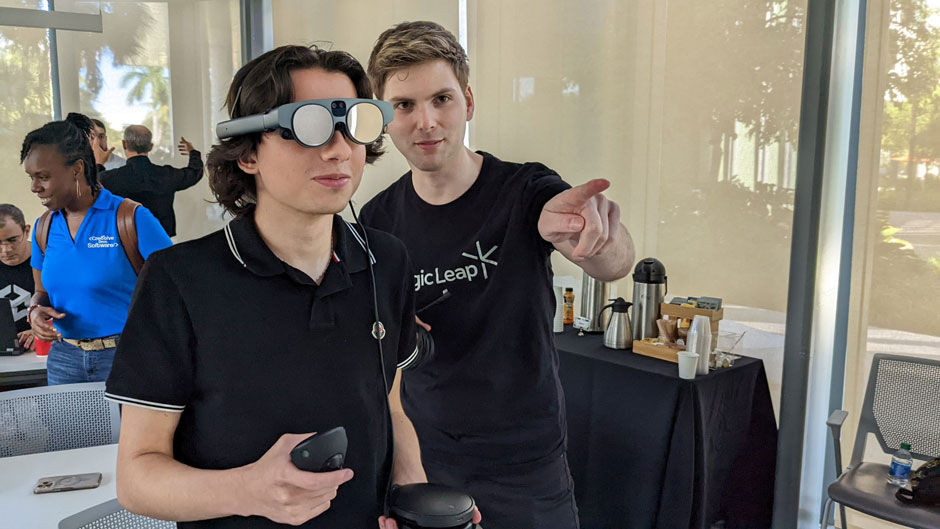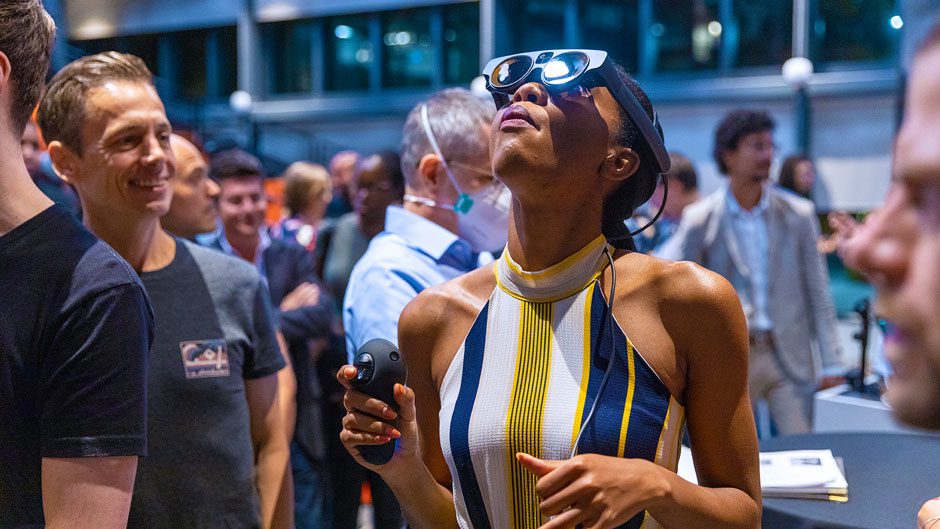On Friday, Magic Leap announced that its next generation enterprise augmented reality platform, Magic Leap 2, is now commercially available.
Widespread availability follows its Early Access Program with companies like Cisco, SentiAR, NeuroSync, Miami-based Heru, Taqtile, PTC and Brainlab, where Magic Leap continued to improve the device for training, communication and remote assistance use cases in clinical settings, industrial environments, defense, and retail stores.
Magic Leap CEO Peggy Johnson said: “The Magic Leap 2 is the smallest and lightest augmented reality device built for the enterprise. After working with customers across industries like healthcare, manufacturing and the public sector, we’re proud to release a device that features innovative breakthroughs critical to driving widespread adoption, including Dynamic Dimming™ technology, the industry’s largest field of view, and unparalleled image quality and text legibility. Magic Leap 2 will take the current use cases to the next level, and we can’t wait to see what our customers create.”
In addition to Dynamic Dimming, Magic Leap 2 is 20% lighter and 50% smaller than its predecessor and includes proprietary optics breakthroughs and the largest field of view (up to 70° diagonal), compared to similar currently available AR devices, Magic Leap says.
The University of Miami has been a Magic Leap partner since 2018. Recently, students, faculty and the developer community were able to try out the Magic Leap 2 with a Magic Leap executive. Here is UM’s report:
By Janette Neuwahl Tannen – Guest Contributor, University of Miami
In a Magic Leap 2 Developer Event held in September, the company let students, faculty members, staff, and local professionals learn more about the newest headset, set to be released Sept. 30.
Oscar Arana and George Thompson have a vested interest in being familiar with the latest technology.
Thompson, a first-year music engineering major, and Arana, a sophomore computer science major, hope to delve into the virtual or augmented reality industries after graduation.
So, on Tuesday evening, they joined a group of students, faculty and staff members, and local extended reality professionals who attended the VR/AR Association’s Magic Leap 2 Developer Event, where leaders from Plantation-based Magic Leap unveiled the latest headsets, which will officially hit the market at the end of the month.
“The headset is very cool, and it will be interesting to think about its applications—I’m excited to see what will come out of it,” said Arana.
Founded by University alumnus Rony Abovitz in 2010, Magic Leap is one of a few companies specializing in augmented reality hardware, which layers digital images and experiences on top of the physical world. For example, augmented reality (AR) applications allow consumers to visualize digital furniture in their actual home, and they could allow first responders to immediately visualize hazards currently hidden behind walls, like gas lines or electrical panels when entering a fire in an actual building.
“The key to the future of digital technology in the physical world is keeping the human at its center,” said Lisa Watts, vice president of product marketing and developer programs at Magic Leap. “And we are here to make that digital content truly exist in the physical world and to enable humans to have that next level of interaction.”
The Tuesday event was hosted by the University’s Institute for Data Science and Computing (IDSC) and the XR Initiative and held in the Lakeside Village Auditorium. It was sponsored by Magic Leap and Unity, which creates software that is often used to build virtual and augmented reality experiences. It came just a few months after the Miami chapter of the VR/AR Association was launched on campus last spring.
“Magic Leap 2 has more capabilities to bring the digital and physical world together, and the University wants to be at the forefront of these technologies to expose our faculty and students to these new realities,” said Nick Tsinoremas, the University’s vice provost for research computing and data, as well as director of IDSC. “We are very excited about our relationship with Magic Leap and Unity, as well as how we can advance this technology and make it more pervasive. Because we want to create the next generation of developers, the next generation of creators, and the next generation of people that can change the world.”

During the evening event, Watts explained that the Magic Leap 2 evolved from the company making many revisions to its first headset, the Magic Leap One, to make it more human-centric. Some of these include expanding the user’s field of vision, so that people wearing the headsets can see a wider area.
The company also worked to make the digital images appear more solid before they are layered on the physical world, Watts noted. The new device also has more than 18 cameras and sensors, four microphones, and two speakers to make the AR experience more engaging.
The new headsets also have a global dimming feature that allows digital images to become sharper. In addition, Magic Leap has made its platform more accessible to developers and switched to an Android-based operating system. The device costs $3,299.
The new features will help the headsets become more useful to people outdoors or in bright light, students and faculty members familiar with the previous headsets pointed out. Sophomore Marcos Morales, who works on the information technology Innovate team to develop Magic Leap applications with faculty members, said many of the changes were positive.
“It’s a large improvement on how much you’re able to see onscreen in the new device, and the virtual objects look much more real,” he said.
In 2018, Magic Leap and the University entered a partnership where students and faculty and staff members developed new uses for the devices. Through Magic Leap mini-grants sponsored by the Office of the Provost, applications were crafted to do things like teach three-dimensional vectors in physics and for surgeons to view and interact with 3-D images of a patient’s struggling organs.
Now, the hope is that the University community and professionals from a burgeoning Miami tech industry will help them develop more applications for the Magic Leap 2.
“In this new headset, we’ve given you more tools to help that digital content really blend into the real world,” Watts said, speaking to an audience of potential Magic Leap developers. “And you as the development community need to help us bring this to life. So, we want to enable you and give you access to the possibilities.”
Photo at top of post: A participant at the Magic Leap 2 Developer Event gets a chance to try on the company’s latest headset. Photo: Matthew Rembold/University of Miami.
This story was first published by the University of Miami and Refresh Miami here is republishing it with permission.
- Human ingenuity, inspiration, a call to action: Miami Tech Talent Coalition takes the stage at eMerge Americas - April 24, 2024
- Miami Tech Month, where developers get their own conference, VCs take the stage, and anything is POSSIBLE - April 23, 2024
- Full circle moment for Johanna Mikkola, the new CEO for Tech Equity Miami - April 22, 2024





